Imagine playing Jenga with a set that contains one faulty block. Near the end of your game, you tap the end of the Jenga block to free it from the stack, and it cracks in half. The whole structure comes tumbling down. Your game is ruined.
That faulty block is a result of bad quality assurance. The manufacturer of that block didn’t do a good job of ensuring that every set produced was of the highest quality.
In this article, we’ll walk you through the basics of quality assurance, including what it is, how it fits in the entire quality system, and how to execute successful quality assurance in several different industries.
What is quality assurance?
Quality assurance (QA) is the process of ensuring a product or service meets a company’s quality standards.
It’s rooted in the manufacturing industry, where companies use QA to ensure that each product produced is perfectly put together.
QA is a process used and valued across all industries to increase a customer’s satisfaction and confidence in their purchases, while improving a company’s credibility. Customers that receive high-quality products every time they make a purchase are more likely to become loyal.Companies manage QA by building project quality plans with tools like monday.com. A project quality plan starts with establishing a process that leaves minimal room for mistakes.
monday.com’s process management template is a great place for project managers to build their own custom QA processes.
Projects are broken down into different phases that are tracked on their timelines, all mapping back to the largest project plan.
You can easily assign owners and priority levels for every task and view progress at a glance with the monday.com progress bar.
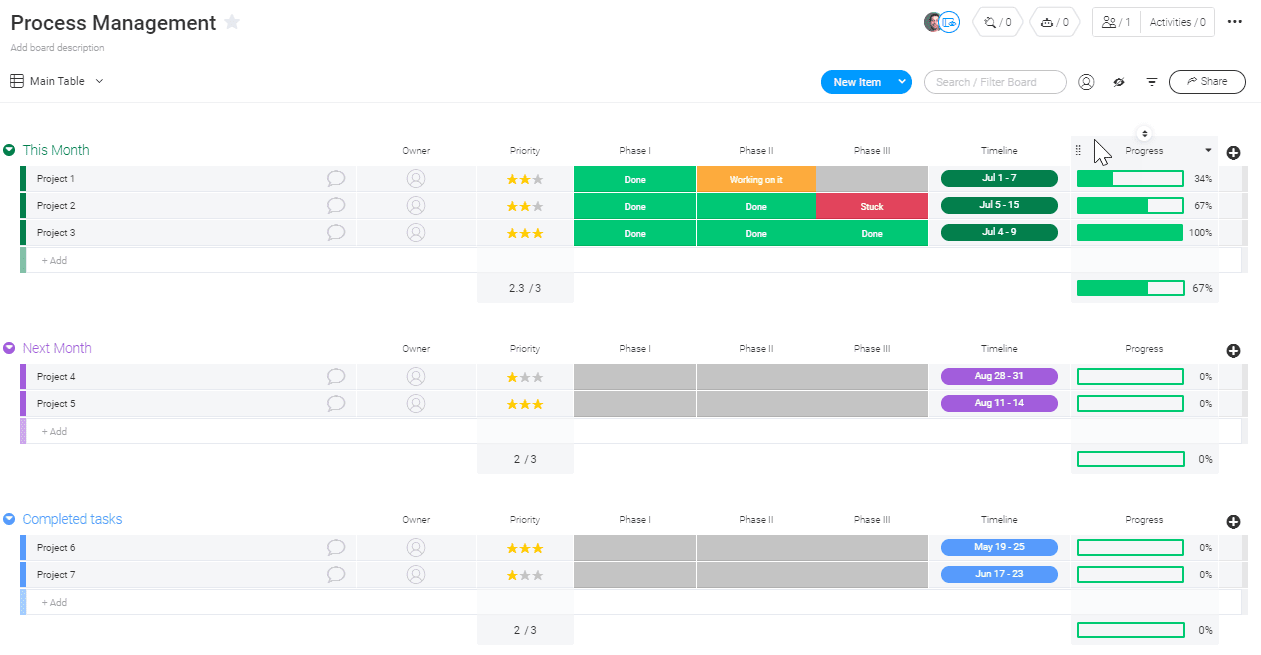
With templates like this, project managers can take the first steps toward ensuring their project’s deliverables are of the highest quality every time.
QA processes have become so critical for some businesses that they create a quality assurance department. The QA team is responsible for implementing quality checks within the manufacturing process.
Quality system vs. quality assurance vs. quality control
The term quality assurance is often used interchangeably with quality management system or quality control (QC) — but they’re not the same.
QC and QA are part of the bigger quality control system.
Quality assurance typically covers the entire quality system, whereas quality control is a smaller subset of that system. There are also additional elements of a quality system that might not be covered by QA or QC at all.
Here’s how each is defined:
- Quality assurance: as we mentioned above, the purpose of QA is to provide confidence that quality requirements will be fulfilled. Instilling confidence in your customers is of the highest priority, but this also includes instilling confidence in upper management, government agencies, regulators, certifiers, and any other third-party that may be a key stakeholder in your product or service operations.
- Quality control: QC is the part of QA that specifically focuses on meeting a set of quality requirements. QA includes everything needed to produce a quality product, including the process and team. QC typically covers product inspections and technical operations.
- Quality system: the quality system includes QA and QC, along with anything else that goes into ensuring a product is made to the highest standard. For instance, personnel issues and company goals are also part of the quality system, but they don’t necessarily fall under QA or QC.
Take a clothing manufacturer, for example. Quality control includes the technical inspection of the clothes as they are produced, including fabric quality, construction, coloring, and more.
Quality assurance covers the manufacturing process as a whole, including vendors, materials, the step-by-step production process, and anything else required to get the job done.
The quality system is the whole package. It includes things like hiring the right people to manage the process, in addition to other high-level management activities.
When you put the whole thing together, the system can be visualized like so:
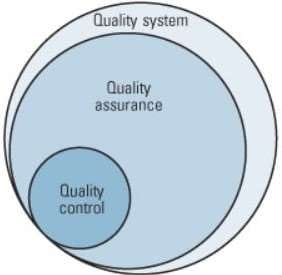
Now, let’s focus on how to execute effective QA in several different departments.
Quality assurance methods
There are 3 types of quality assurance methods frequently used by companies. This can change depending on the types of products they’re selling and their QA needs.
But all 3 methods rest on 2 primary foundations:
- Physically testing your product’s strength
- Using analysis and quantitative methods to calculate whether or not your product will hold up
Let’s explore each of them.
1. Failure testing
During this process, teams will continuously test a product until it breaks or fails.
For physical products, we mean physically break, crack or break down under pressure. For example, a tights manufacturer might continuously test their product by stretching and pulling the fabric until it runs.
This also includes software products. For example, a fintech company might continuously test its platform to see how many transactions it can withstand at once.
2. Statistical process control (SPC)
SPC is the use of statistical methods to manage the control and production of products.
Developed by Walter Shewhart at Western Electric Company and Bell Telephone Laboratories in the 1920s and 1930s, this method is most commonly used for products that are built on complex technology or use a mix of chemicals.
For example, a company that produces the infrastructure for data security firms might use statistical methods to test their hardware before installation.
A paint company might use these methods to test whether or not its outdoor paint solution will hold up to different elements.
3. Total quality management (TQM)
The TQM method applies quantitative methods to ensure that products are continually improving. This means teams rely on facts, data, and analysis to support how products are reviewed or planned in the future.
Consider a company that produces ergonomic desk chairs. It might use a combination of failure testing and feedback from customers to determine whether or not the product needs to be adapted for optimal performance.
No matter which QA method you’re using, you need an execution plan. Whether you’re working to produce physical products, software, constructing buildings, or creating a product that people will consume, it’s important to understand how to execute QA processes within your space.
Examples of quality assurance execution by industry
Just because quality assurance is rooted in manufacturing doesn’t mean that other industries can’t take advantage of its effectiveness in terms of increasing customer satisfaction and confidence in their products.
We’ll walk you through the process in the following 4 industries:
- Manufacturing
- Software development
- Construction
- Pharmaceuticals
Manufacturing
When you’re manufacturing a product, quality assurance is about testing that product during the manufacturing process to make sure it’s of the highest quality.
This is meant to ensure that customers never receive any defective products.
In some cases, a defect in a product isn’t harmful to customers, like receiving a dress with a hole in it. In other cases, they can be life-threatening, like if a vehicle airbag isn’t produced properly.
A recent defect found in Takata airbags eventually ended in one of the largest automobile recalls in history, including 69 million airbag inflators. It probably cost the company billions of dollars. The recall lasted through 2019 and took until the end of 2020 to resolve.
The best way to make sure this doesn’t happen with your products is to build QA into your overall manufacturing process.
monday.com’s manufacturing template provides a framework for operations teams to weave their QA process into the manufacturing process.
Instead of main steps like design, build, and ship, as pictured below, steps for testing or analysis can be added to assist teams in QA.
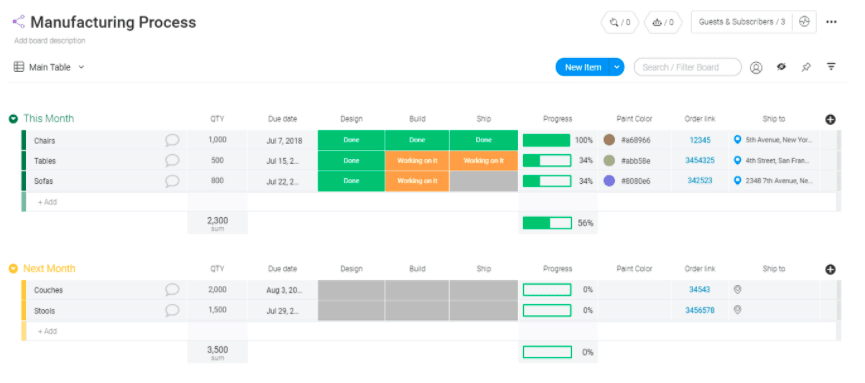
Another solution is to ensure that QA is in sync with production tracking. Depending on the volume of items in production, QA might be needed more or less frequently. It might even have to change altogether.
Our production tracking template supports operations teams in implementing QA in alignment with production tracking.
![]()
Software development
Products that aren’t physical can still be faulty, break, and cost millions of dollars in losses if they need repair.
QA has become a big part of software development, helping engineers test and monitor the quality of their products continuously.
It’s so popular that it’s even got its own abbreviation. Software quality assurance (SQA) works to find patterns and actions that teams need to perform in order to improve their development cycles.
This includes identifying and fixing coding errors that can cause negative consequences, like a data breach or unwanted downtime.
This type of software testing is the key to ensuring that products and user data are secure. It’s also vital for catching any problems that occur along the way during the development cycle.
Software testing also makes sure the fixes for certain items don’t have unintended consequences themselves. You can break one thing by fixing another.
SQA helps developers avoid errors before software goes live. In fact, QA is built into many major project management methodologies used by development teams.
Some of these include:
- Waterfall: this methodology follows a linear timeline, and projects are completed in sequential steps. This is the most popular method for managing the systems development life cycle (SDLC) for software engineering and IT projects. At the end of the process, requirements are reviewed by the customer to ensure quality.
- Agile: this methodology is based on taking an incremental, iterative approach to software development. In place of in-depth plans from the beginning of a project, Agile methodologies are open to changing requirements over time and encourage constant feedback from the customers who will ultimately use the product.
Teams work cross-functionally over a period of time. Work is organized into a feature or product backlog that is prioritized based on business or customer value.
- Scrum: this is a well-known process framework that’s a subset of Agile. It’s built on an iterative software development model. Teams work in iterations called sprints, which last 1-2 weeks. This way, teams ship software regularly, while also regularly reviewing progress and measuring quality.
monday.com’s sprint planning template allows development teams to plan sprints under Scrum guidelines, easily working quality assurance into their process.
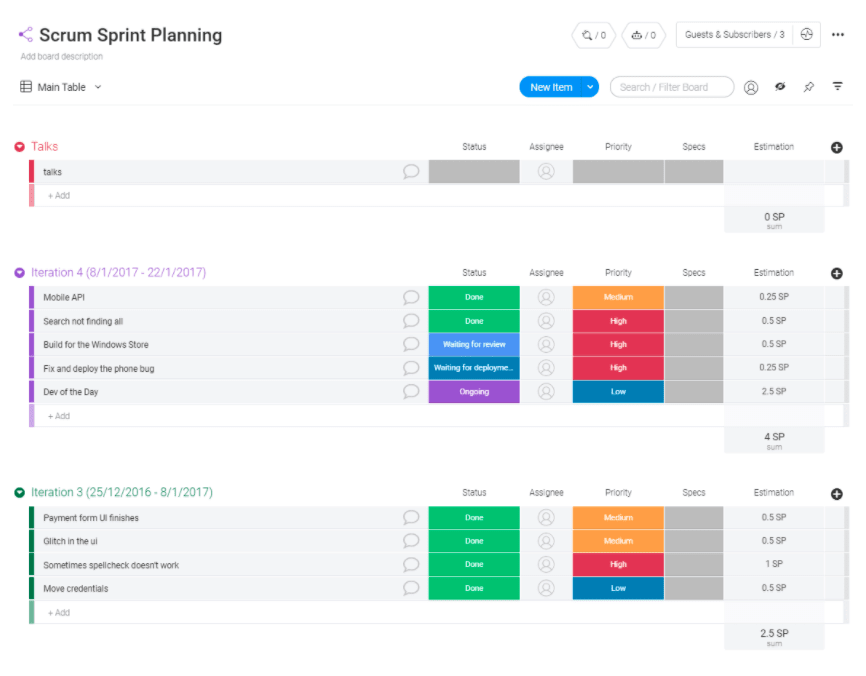
Teams also use monday.com to manage their feature backlog, easily collecting and prioritizing feature requests, bugs, and updates all in one place.
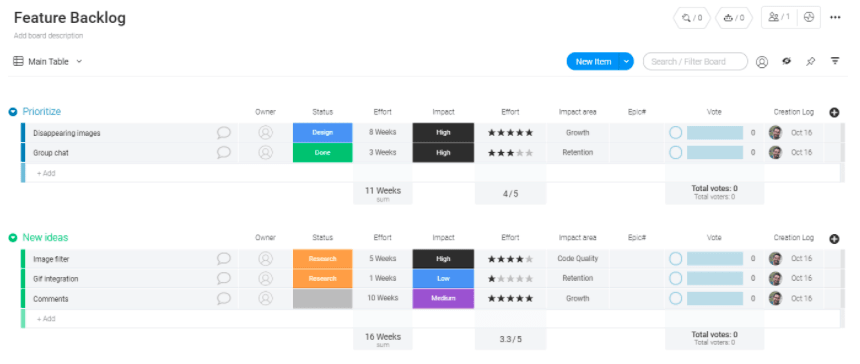
Construction
Construction teams must rely on quality assurance to make sure their final products — be it infrastructure, building, homes, or another type of project — are of the highest quality and safe for customers and the general public.
Many people only think about the final inspection when they think about quality control activity or quality management in the construction industry, but it’s a much more integral part of the process.
Construction teams keep track of quality as work happens in real-time, and report back daily on any issues they’ve found to ensure they’re fixed as progress is made.
Construction teams of all sizes often use monday.com to build their construction quality control plans. The following illustrates a template for construction project details, including implementing quality checks along the way.
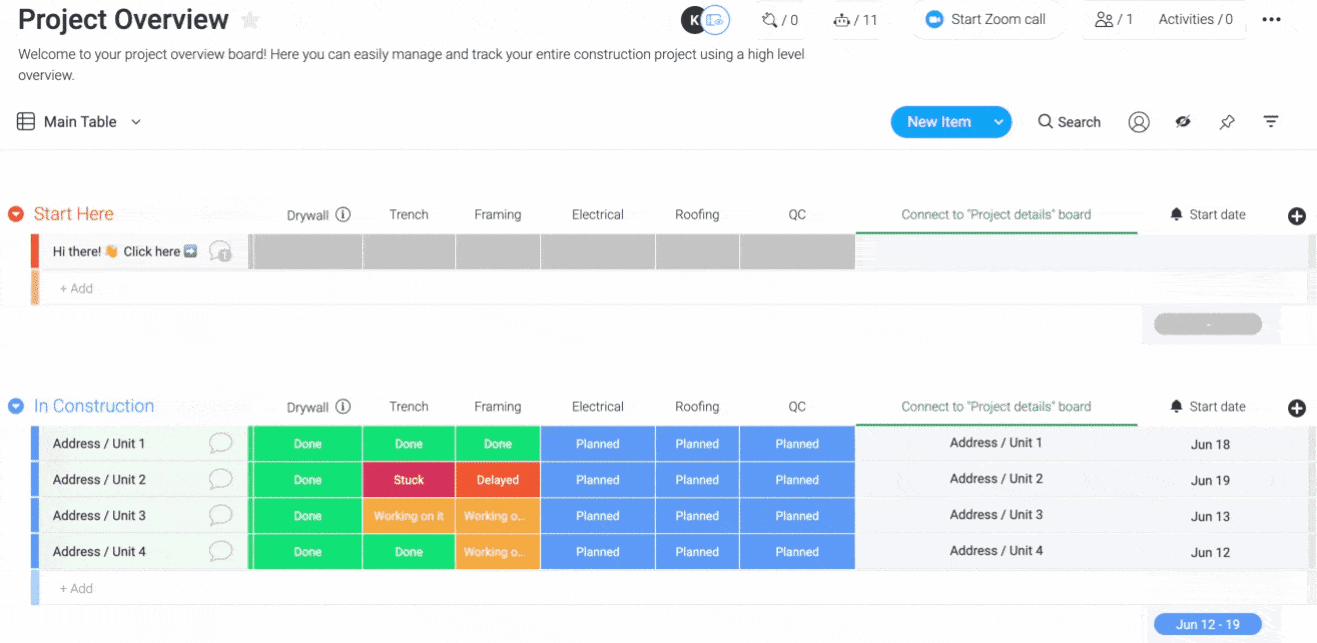
Here’s how this template can be adapted for construction quality control, including tracking different phases in a project’s completion with clear ownership and timelines.
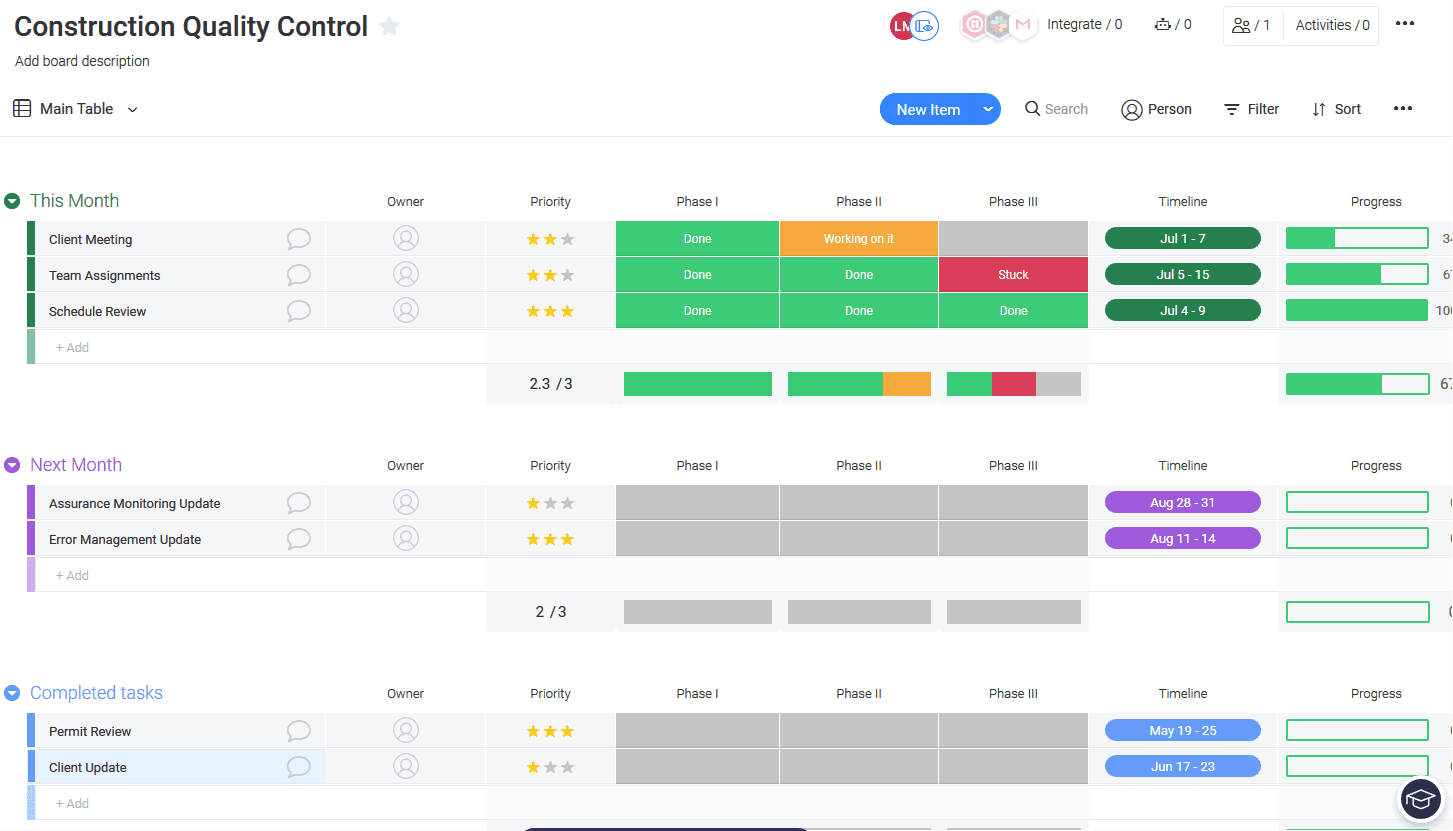
Pharmaceuticals
As you can imagine, pharmaceutical quality assurance is a big priority. Defective medication could prove to be disastrous to the customer and the manufacturer. Sufficient resources should be allocated to ensure the quality of every product.
In 2010, the consequences of defective pain relievers were detrimental. The Federal Food and Drug Administration (FDA) recommended Johnson and Johnson recall millions of bottles of over-the-counter infant pain reliever.
The recall was recommended as there were manufacturing quality problems. The recall didn’t end the problem, though. Just 5 years later, Johnson and Johnson were still battling the FDA over the recall. Then 6 years later, lawyers were still offering free consultations to affected families.
Pharmaceutical companies can use monday.com to implement QA within manufacturing processes.
To start, teams can build a custom manufacturing plan and QA process using monday.com’s project tracker. It allows for attributing different tasks to different owners based on the stages of your manufacturing process.
It also makes status updates easy, with a color-coded drag-and-drop user interface. There’s never any question as to the tasks that have been done and those that are still in the works.
![]()
Regardless of your industry, the trick to effective QA is redundancy and making sure that you’re continuously testing your products throughout production.
Choose the right software to meet your quality assurance needs
Without an effective quality assurance process, companies risk rolling out bad products. This decreases confidence in your product from potential customers, negatively damages your brand perception, and can in some cases cause physical harm.
Make sure everything you produce is of the highest quality by building your QA process with monday.com, a customizable and robust Work OS that stands as the foundation for your needs.

